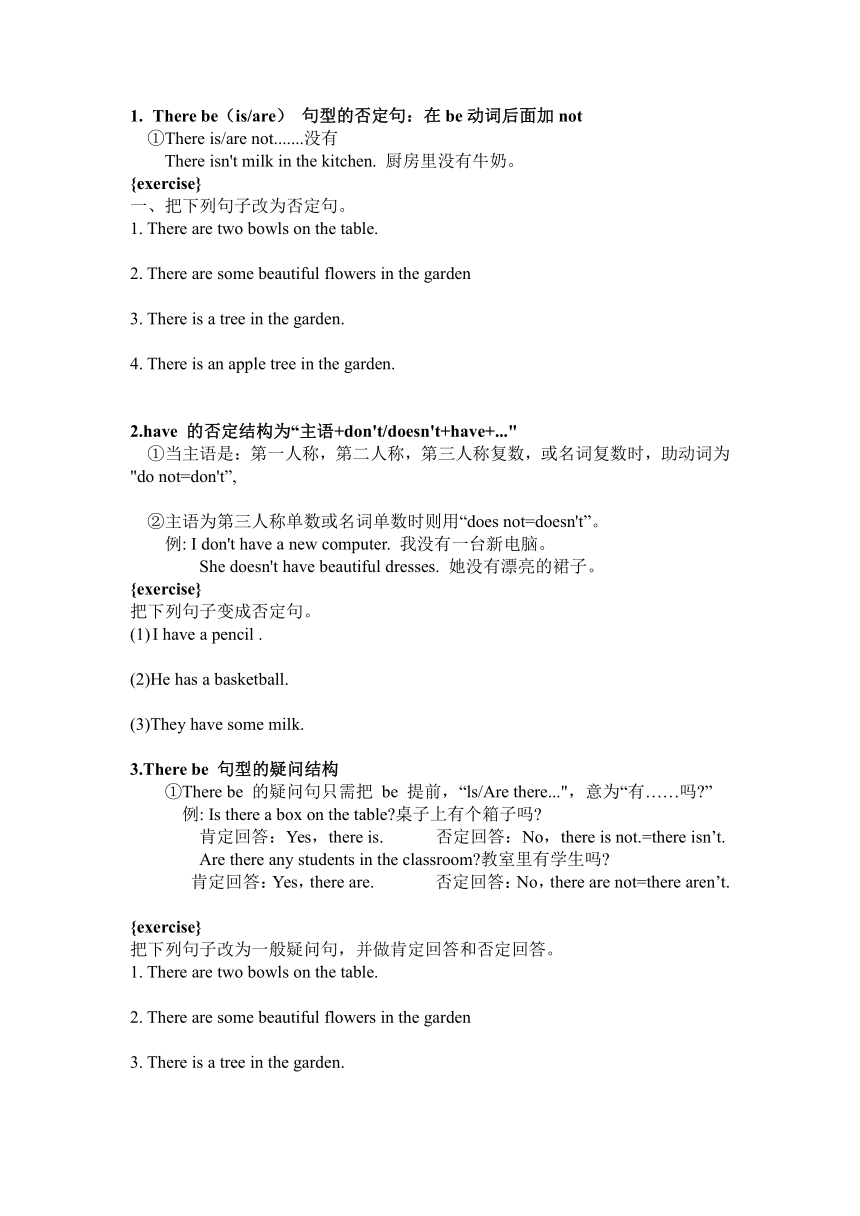2023-2024学年教科版(广州)英语六年级下册 There be 句型和have的区别讲义 +练习(无答案)
文档属性
| 名称 | 2023-2024学年教科版(广州)英语六年级下册 There be 句型和have的区别讲义 +练习(无答案) |  | |
| 格式 | docx | ||
| 文件大小 | 22.3KB | ||
| 资源类型 | 教案 | ||
| 版本资源 | 教科版(广州) | ||
| 科目 | 英语 | ||
| 更新时间 | 2024-05-15 15:41:32 | ||
图片预览


文档简介
There be 句型和have/has的区别
1.there be表示“有”,侧重客观存在,某地/某时有.
There is a book on the desk.课桌上有一本书。
There is going to be a meeting this afternoon.今天下午将有一个会议。
There is some water in the bottle. 杯子里有一些水。看近不看远
<就近原则> 单数/不可数用is
There are many apples and water on the table. 复数主语要用are
桌子上有许多苹果。
There is much water and apples on the table.复数主语要用is
②have/has表示"拥有”,侧重所属关系,某人/某物有…
She has a dog.她有一只狗。。
The desk has four legs.桌子有四条腿。 注意:无there have/has表达!
过去式用had
I had an apple yesterday.我昨天有一个苹果。
专项练习:
have / has / There be专项练习←
用 have 、has 或There be 填空
1. The cat __________two big eyes.
2.__________ some water in the cup.
3._________20 students in our class.
4. My father __________a new car.
5.I__________a nice toy.
6. __________a cat in the classroom.
7._________an English book on the desk.
8. He __________a ball.
9.It__________a long nose.
10. __________ some apples on the table.
11.Tom __________some toys.
12.__________ four boys in our class.
13. There __________a child and a woman in the shop(商店).
14.The dog_________a short tail.
15._________a banana in the bag.
16.____________five birds and a hamster in the box.
{There be句型和have/has句型的否定和疑问结构}
一、There be 句型
There be(is/are) 句型的否定句:在be动词后面加not
①There is/are not.......没有
There isn't milk in the kitchen. 厨房里没有牛奶。
{exercise}
把下列句子改为否定句。
1. There are two bowls on the table.
2. There are some beautiful flowers in the garden
3. There is a tree in the garden.
4. There is an apple tree in the garden.
2.have 的否定结构为“主语+don't/doesn't+have+..."
①当主语是:第一人称,第二人称,第三人称复数,或名词复数时,助动词为
"do not=don't”,
②主语为第三人称单数或名词单数时则用“does not=doesn't”。
例: I don't have a new computer. 我没有一台新电脑。
She doesn't have beautiful dresses. 她没有漂亮的裙子。
{exercise}
把下列句子变成否定句。
I have a pencil .
(2)He has a basketball.
(3)They have some milk.
3.There be 句型的疑问结构
①There be 的疑问句只需把 be 提前,“ls/Are there...",意为“有……吗 ”
例: Is there a box on the table 桌子上有个箱子吗
肯定回答:Yes,there is. 否定回答:No,there is not.=there isn’t.
Are there any students in the classroom 教室里有学生吗
肯定回答:Yes,there are. 否定回答:No,there are not=there aren’t.
{exercise}
把下列句子改为一般疑问句,并做肯定回答和否定回答。
1. There are two bowls on the table.
2. There are some beautiful flowers in the garden
3. There is a tree in the garden.
4. There is an apple tree in the garden.
4.have 的疑问句结构为“Do/Does+主语+have+..."{注:have 的单复数遵循"主谓一致”}
当主语是第一第一人称,第二人称,第三人称复数,或名词复数时,用助动词do
当主语是第三人称单数的时候,用助动词does.
例:Do you have a bike 你有自行车吗
肯定回答:Yes,I do.
否定回答:No,I do not=don’t
Does the boy have a dog 这个男孩有条狗吗
肯定回答:Yes,he does.
否定回答:No,he doesn’t.
把下列句子改为疑问句并做肯定回答和否定回答。
1.I have a pencil .
2.He has a basketball.
3.They have some milk.
专项练习:
一、把下列there be句子改成疑问句,并做肯定回答和否定回答。
1. There are four apples on the ground.
There are some birds in the tree.
There is an armchair in the living room.
There’s a sofa in the living room
There’s a duck in the river.
二、把下列have的句子改为否定句,疑问句,并做肯定回答和否定回答。
(1)My sister has a dictionary.
They have three cats.
(3)I have a pencil.
三、用is, am, are填空,把句子补充完整。
1.I _______ a boy (男孩).
2.They _______ boys.
3.Where _______ they now.
4.Where _______ my mother
5.Where _______ my book
四、用英文翻译下列句子(8分)
1.一个文具盒在书桌上。
_____________________________________________
2.两个玩偶在箱子里。
_____________________________________________
3.一个红色的球在椅子附近。
_____________________________________________
4.我的玩具飞机在桌子下面。
_____________________________________________
1.there be表示“有”,侧重客观存在,某地/某时有.
There is a book on the desk.课桌上有一本书。
There is going to be a meeting this afternoon.今天下午将有一个会议。
There is some water in the bottle. 杯子里有一些水。看近不看远
<就近原则> 单数/不可数用is
There are many apples and water on the table. 复数主语要用are
桌子上有许多苹果。
There is much water and apples on the table.复数主语要用is
②have/has表示"拥有”,侧重所属关系,某人/某物有…
She has a dog.她有一只狗。。
The desk has four legs.桌子有四条腿。 注意:无there have/has表达!
过去式用had
I had an apple yesterday.我昨天有一个苹果。
专项练习:
have / has / There be专项练习←
用 have 、has 或There be 填空
1. The cat __________two big eyes.
2.__________ some water in the cup.
3._________20 students in our class.
4. My father __________a new car.
5.I__________a nice toy.
6. __________a cat in the classroom.
7._________an English book on the desk.
8. He __________a ball.
9.It__________a long nose.
10. __________ some apples on the table.
11.Tom __________some toys.
12.__________ four boys in our class.
13. There __________a child and a woman in the shop(商店).
14.The dog_________a short tail.
15._________a banana in the bag.
16.____________five birds and a hamster in the box.
{There be句型和have/has句型的否定和疑问结构}
一、There be 句型
There be(is/are) 句型的否定句:在be动词后面加not
①There is/are not.......没有
There isn't milk in the kitchen. 厨房里没有牛奶。
{exercise}
把下列句子改为否定句。
1. There are two bowls on the table.
2. There are some beautiful flowers in the garden
3. There is a tree in the garden.
4. There is an apple tree in the garden.
2.have 的否定结构为“主语+don't/doesn't+have+..."
①当主语是:第一人称,第二人称,第三人称复数,或名词复数时,助动词为
"do not=don't”,
②主语为第三人称单数或名词单数时则用“does not=doesn't”。
例: I don't have a new computer. 我没有一台新电脑。
She doesn't have beautiful dresses. 她没有漂亮的裙子。
{exercise}
把下列句子变成否定句。
I have a pencil .
(2)He has a basketball.
(3)They have some milk.
3.There be 句型的疑问结构
①There be 的疑问句只需把 be 提前,“ls/Are there...",意为“有……吗 ”
例: Is there a box on the table 桌子上有个箱子吗
肯定回答:Yes,there is. 否定回答:No,there is not.=there isn’t.
Are there any students in the classroom 教室里有学生吗
肯定回答:Yes,there are. 否定回答:No,there are not=there aren’t.
{exercise}
把下列句子改为一般疑问句,并做肯定回答和否定回答。
1. There are two bowls on the table.
2. There are some beautiful flowers in the garden
3. There is a tree in the garden.
4. There is an apple tree in the garden.
4.have 的疑问句结构为“Do/Does+主语+have+..."{注:have 的单复数遵循"主谓一致”}
当主语是第一第一人称,第二人称,第三人称复数,或名词复数时,用助动词do
当主语是第三人称单数的时候,用助动词does.
例:Do you have a bike 你有自行车吗
肯定回答:Yes,I do.
否定回答:No,I do not=don’t
Does the boy have a dog 这个男孩有条狗吗
肯定回答:Yes,he does.
否定回答:No,he doesn’t.
把下列句子改为疑问句并做肯定回答和否定回答。
1.I have a pencil .
2.He has a basketball.
3.They have some milk.
专项练习:
一、把下列there be句子改成疑问句,并做肯定回答和否定回答。
1. There are four apples on the ground.
There are some birds in the tree.
There is an armchair in the living room.
There’s a sofa in the living room
There’s a duck in the river.
二、把下列have的句子改为否定句,疑问句,并做肯定回答和否定回答。
(1)My sister has a dictionary.
They have three cats.
(3)I have a pencil.
三、用is, am, are填空,把句子补充完整。
1.I _______ a boy (男孩).
2.They _______ boys.
3.Where _______ they now.
4.Where _______ my mother
5.Where _______ my book
四、用英文翻译下列句子(8分)
1.一个文具盒在书桌上。
_____________________________________________
2.两个玩偶在箱子里。
_____________________________________________
3.一个红色的球在椅子附近。
_____________________________________________
4.我的玩具飞机在桌子下面。
_____________________________________________
